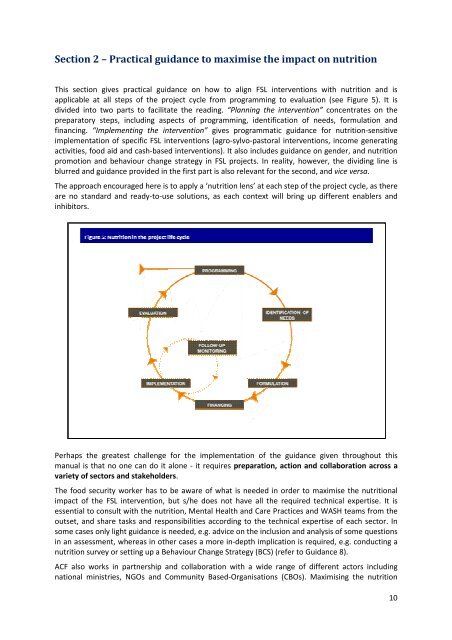Maximising the Nutritional Impact of FSL Interventions FINAL
Maximising the Nutritional Impact of FSL Interventions FINAL
Maximising the Nutritional Impact of FSL Interventions FINAL
You also want an ePaper? Increase the reach of your titles
YUMPU automatically turns print PDFs into web optimized ePapers that Google loves.
Section 2 – Practical guidance to maximise <strong>the</strong> impact on nutrition<br />
This section gives practical guidance on how to align <strong>FSL</strong> interventions with nutrition and is<br />
applicable at all steps <strong>of</strong> <strong>the</strong> project cycle from programming to evaluation (see Figure 5). It is<br />
divided into two parts to facilitate <strong>the</strong> reading. “Planning <strong>the</strong> intervention” concentrates on <strong>the</strong><br />
preparatory steps, including aspects <strong>of</strong> programming, identification <strong>of</strong> needs, formulation and<br />
financing. “Implementing <strong>the</strong> intervention” gives programmatic guidance for nutrition-sensitive<br />
implementation <strong>of</strong> specific <strong>FSL</strong> interventions (agro-sylvo-pastoral interventions, income generating<br />
activities, food aid and cash-based interventions). It also includes guidance on gender, and nutrition<br />
promotion and behaviour change strategy in <strong>FSL</strong> projects. In reality, however, <strong>the</strong> dividing line is<br />
blurred and guidance provided in <strong>the</strong> first part is also relevant for <strong>the</strong> second, and vice versa.<br />
The approach encouraged here is to apply a ‘nutrition lens’ at each step <strong>of</strong> <strong>the</strong> project cycle, as <strong>the</strong>re<br />
are no standard and ready-to-use solutions, as each context will bring up different enablers and<br />
inhibitors.<br />
Perhaps <strong>the</strong> greatest challenge for <strong>the</strong> implementation <strong>of</strong> <strong>the</strong> guidance given throughout this<br />
manual is that no one can do it alone - it requires preparation, action and collaboration across a<br />
variety <strong>of</strong> sectors and stakeholders.<br />
The food security worker has to be aware <strong>of</strong> what is needed in order to maximise <strong>the</strong> nutritional<br />
impact <strong>of</strong> <strong>the</strong> <strong>FSL</strong> intervention, but s/he does not have all <strong>the</strong> required technical expertise. It is<br />
essential to consult with <strong>the</strong> nutrition, Mental Health and Care Practices and WASH teams from <strong>the</strong><br />
outset, and share tasks and responsibilities according to <strong>the</strong> technical expertise <strong>of</strong> each sector. In<br />
some cases only light guidance is needed, e.g. advice on <strong>the</strong> inclusion and analysis <strong>of</strong> some questions<br />
in an assessment, whereas in o<strong>the</strong>r cases a more in-depth implication is required, e.g. conducting a<br />
nutrition survey or setting up a Behaviour Change Strategy (BCS) (refer to Guidance 8).<br />
ACF also works in partnership and collaboration with a wide range <strong>of</strong> different actors including<br />
national ministries, NGOs and Community Based-Organisations (CBOs). <strong>Maximising</strong> <strong>the</strong> nutrition<br />
10

















